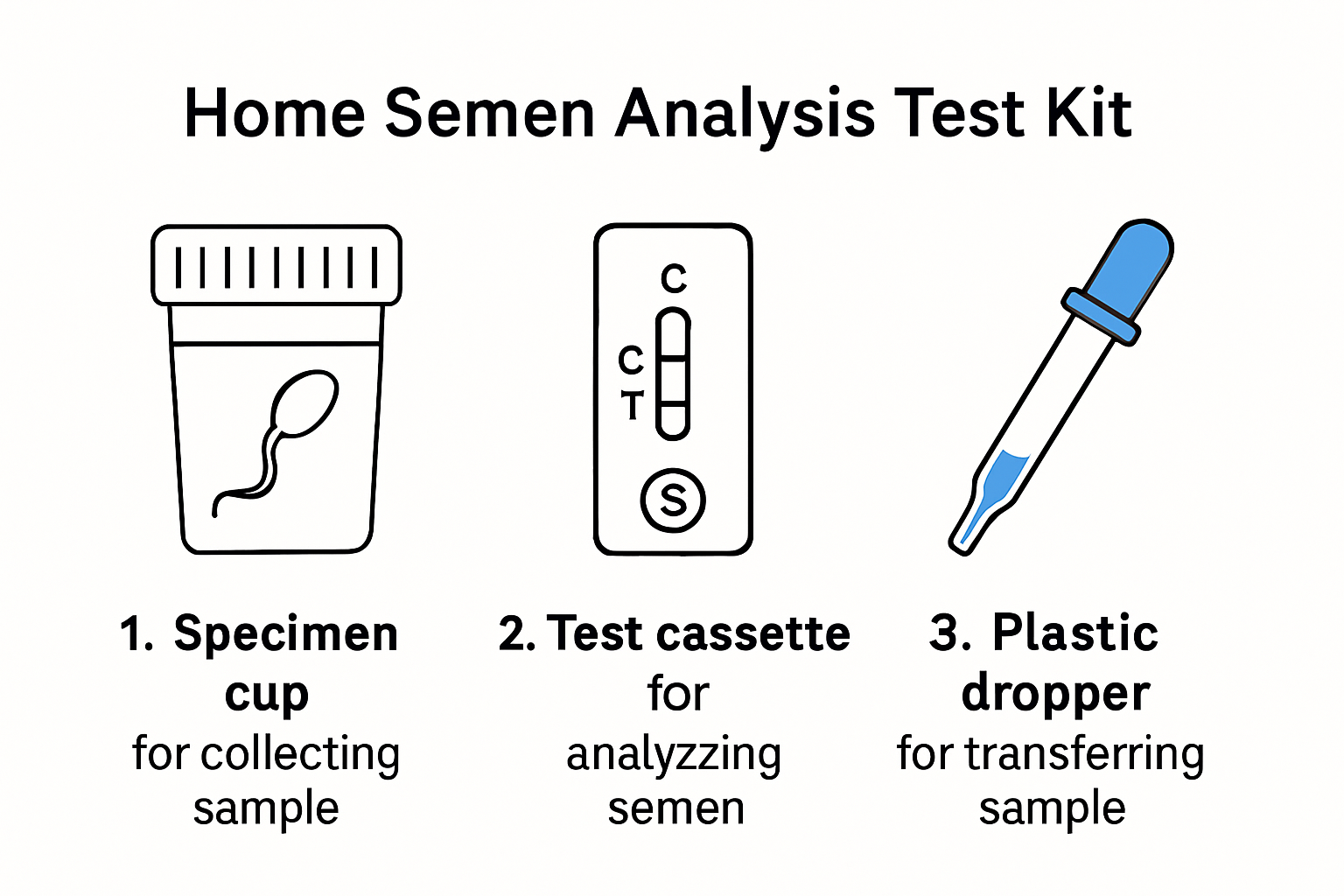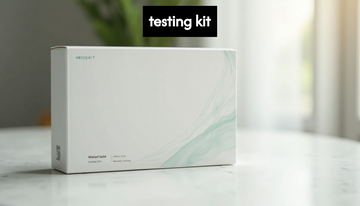Home testing kits for semen analysis are revolutionizing personal health care. They provide a sense of empowerment and privacy, allowing individuals to assess their reproductive health from home. Research indicates that these kits can achieve up to 96% accuracy in predicting sperm counts, which is remarkable for a DIY solution. But here’s the kicker: many people underestimate the importance of understanding each component of these kits. The real game-changer isn’t just the results you get—it’s how you handle the entire process. From unpacking the kit to interpreting your results, every detail matters in your journey toward understanding fertility and post-vasectomy status.
Table of Contents
Quick Summary
| Takeaway | Explanation |
| Proper Handling is Essential | Carefully examine and follow instructions before testing to ensure accurate results; external factors can affect testing reliability. |
| Understand Kit Components | Familiarize yourself with each component’s purpose, such as the sterile collection container and preservation solution, to optimize the testing process. |
| Professional Confirmation is Crucial | Treat home test results as preliminary; professional medical consultation is recommended to verify results and ensure comprehensive understanding of reproductive health. |
| Follow-Up is Key | Schedule follow-up consultations and consider repeating tests after a waiting period to confirm vasectomy effectiveness. |
| Long-Term Monitoring is Important | Engage in annual health check-ups and keep thorough medical documentation to manage reproductive health proactively. |
Unpacking Your Home Test Kit
Successful semen analysis testing begins the moment you open your home testing kit. Precision and careful handling are critical to obtaining accurate results that can help confirm the success of a vasectomy or assess fertility potential.
Understanding Kit Components
A typical home testing kit for semen analysis contains several essential components designed to facilitate accurate sample collection and evaluation. Most kits include a sterile collection container, detailed instruction manual, pre-addressed shipping envelope, and specific testing materials. Clinical research highlights that proper handling of these components directly impacts test reliability.
Key items you’ll typically find in your kit include:
-
Sterile specimen collection cup
-
Protective transportation bag
-
Detailed step-by-step instructions
-
Biohazard specimen bag
-
Pre-paid return shipping label
Proper Handling and Preparation
Before beginning your testing process, carefully examine the kit’s contents and read the instructions thoroughly. Medical guidelines emphasize that external factors like temperature and exposure can significantly impact test accuracy. Store the kit at room temperature and away from direct sunlight until you’re ready to collect your sample.
Pay close attention to specific pre-collection requirements. Some kits may require sexual abstinence for a certain period before sample collection, typically 2-7 days. This helps ensure the most accurate representation of sperm count and motility.
Kit Component Best Practices
When unpacking your home testing kit, follow these critical steps to maintain sample integrity:
-
Wash hands thoroughly before handling any kit components
-
Check that all materials are sealed and undamaged
-
Verify the expiration date on testing materials
-
Review instructions completely before beginning the collection process
-
Prepare a clean, private collection area
Understanding that home test kits are designed for user-friendly interpretation, manufacturers include comprehensive instructions. However, this doesn’t replace the importance of careful, methodical handling. Each step matters in ensuring you receive the most accurate possible assessment of your post-vasectomy status or fertility potential.
Remember, the goal is not just to collect a sample, but to collect a sample that provides meaningful, reliable information about your reproductive health. Taking your time, following instructions precisely, and handling the home testing kit components with care are your first steps toward getting the answers you need.
Key Components Explained Simply
Understanding the specific components of a home vasectomy test kit can help ensure accurate sample collection and reliable results. Each item in the kit serves a crucial purpose in the testing process, designed to simplify what was once a complex medical procedure.
Core Testing Materials
Home testing kits are precision tools engineered to provide quick, accurate insights into post-vasectomy fertility status. Clinical research demonstrates that these kits can achieve up to 96% accuracy in predicting sperm counts, making them a reliable alternative to traditional testing methods.
Typical core components include:
-
Sterile collection container
-
Specialized testing reagents
-
Solution for sample preservation
-
Detailed instruction card
-
Patient information documentation
Specimen Collection and Preservation
The collection container is more than just a simple cup. Advanced home testing technologies incorporate specialized design features that help maintain sample integrity during transportation. The preservation solution prevents sample degradation, ensuring that sperm cells remain stable from the moment of collection until laboratory analysis.
Unique design considerations include:
-
Leak-proof container design
-
Temperature-stable preservation medium
-
Precise volume markings
-
Secure sealing mechanism
User-Friendly Design Elements
Designers of home testing kits prioritize ease of use and accuracy. Usability studies revealed that lay volunteers achieved a 97% correct response rate when using these kits, demonstrating their intuitive nature.
Key user-friendly features typically include:
-
Step-by-step visual instructions
-
Pre-addressed, prepaid return shipping envelope
-
Clear labeling and color-coded components
-
Biohazard safety packaging

 The goal of these home testing kits is to transform a potentially anxiety-inducing medical test into a straightforward, manageable process. By breaking down complex medical testing into simple, actionable steps, manufacturers have made post-vasectomy confirmation more accessible than ever before.
The goal of these home testing kits is to transform a potentially anxiety-inducing medical test into a straightforward, manageable process. By breaking down complex medical testing into simple, actionable steps, manufacturers have made post-vasectomy confirmation more accessible than ever before.
While the kit components might seem straightforward, each element is carefully engineered to provide you with accurate, reliable results. Understanding these components empowers you to confidently navigate the testing process, giving you clear insights into your reproductive health with minimal stress and maximum precision.
Accuracy and Safety of DIY Kits
Home testing kits represent a significant advancement in personal health management, offering convenient and private methods for critical health assessments. However, understanding their accuracy and safety parameters is crucial for making informed decisions about your reproductive health.
Precision in Testing Methodology
Vasectomy confirmation kits are engineered with scientific rigor, designed to provide reliable results with minimal user intervention. Research from medical diagnostics experts indicates that well-designed home testing kits can achieve accuracy rates approaching 96-97% when used correctly.
Key factors influencing test accuracy include:
-
Precise measurement standards
-
Standardized testing protocols
-
Quality-controlled testing reagents
-
Comprehensive validation processes
Potential Limitations and User Considerations
While home testing kits offer remarkable convenience, they are not infallible. Clinical studies highlight several critical considerations that can impact test reliability:
-
User technique and adherence to instructions
-
Timing of sample collection
-
Proper sample handling and transportation
-
Environmental factors during testing
Experts recommend treating home test results as preliminary, with professional medical confirmation serving as the definitive assessment. This approach ensures the most comprehensive understanding of your reproductive health status.
Safety Protocols and Quality Assurance
Manufacturers implement multiple safety measures to protect user privacy and ensure reliable testing. Safety features typically include:
-
Sterile, single-use collection materials
-
Biohazard-secure packaging
-
Confidential result reporting
-
Detailed handling instructions
Medical guidelines emphasize the importance of choosing FDA-approved or clinically validated testing kits. These products undergo rigorous testing to meet strict medical standards, providing users with a reliable tool for personal health monitoring.
The evolution of home testing technology continues to narrow the gap between professional laboratory testing and at-home diagnostics. By understanding the capabilities and potential limitations of these kits, you can approach your vasectomy confirmation testing with confidence and informed perspective.
Ultimately, these kits are not replacements for professional medical advice but powerful tools that empower individuals to take proactive steps in managing their reproductive health. Combining home testing with professional medical consultation provides the most comprehensive approach to understanding your post-vasectomy status.
Beyond the Result: Next Steps
Receiving your vasectomy confirmation test results is just one part of your post-procedure journey. Understanding how to interpret and act on these results is crucial for your reproductive health and future family planning.
Interpreting Your Test Results
Home testing results require careful interpretation. The American Urological Association emphasizes that professional medical confirmation remains the gold standard for verifying vasectomy success. A negative result (indicating no sperm) does not automatically mean permanent sterility.
Key considerations when reviewing results include:
-
Understanding the difference between zero sperm and low sperm count
-
Recognizing potential testing limitations
-
Knowing when additional medical consultation is necessary
Follow-Up Recommendations
Regardless of your initial test results, follow-up is critical. Clinical guidelines recommend a comprehensive approach to post-vasectomy confirmation. This typically involves:
-
Scheduling a follow-up consultation with your urologist
-
Potentially repeating the semen analysis
-
Continuing alternative contraception until confirmed sterility
-
Documenting test results for medical records
Most medical professionals suggest waiting at least 2-3 months or 20-30 ejaculations after the procedure before considering the vasectomy fully effective. This waiting period allows for complete clearance of remaining sperm from the reproductive tract.
Long-Term Reproductive Health Monitoring
Proactive health management extends beyond initial testing. Research indicates that 96% of patients find mail-in semen analysis kits convenient, but convenience should not replace comprehensive medical oversight.
Consider these long-term monitoring strategies:
-
Annual reproductive health check-ups
-
Maintaining detailed medical documentation
-
Discussing any concerns with your healthcare provider
-
Understanding potential long-term reproductive changes
While home testing kits provide valuable initial insights, they are tools of empowerment, not definitive medical diagnoses. The most responsible approach combines home testing with professional medical guidance.
Your vasectomy confirmation is a significant milestone in reproductive health management. Approach your results with a balanced perspective: use home testing as an informative first step, but always seek professional medical interpretation and advice.
Remember, every individual’s reproductive journey is unique. What matters most is making informed decisions about your health, backed by professional medical guidance and comprehensive testing.
Frequently Asked Questions
What is a home testing kit for semen analysis?
Home testing kits for semen analysis are tools designed to allow individuals to assess their reproductive health from the comfort of their own homes. These kits typically include materials for collecting and preserving a sperm sample, along with detailed instructions for use.
How accurate are home semen analysis kits?
Research indicates that well-designed home testing kits can achieve accuracy rates approaching 96-97% when used correctly. However, it is important to follow the instructions carefully to ensure reliable results.
What components are included in a home testing kit?
A typical home testing kit for semen analysis includes a sterile specimen collection cup, a detailed instruction manual, a protective transportation bag, a biohazard specimen bag, and a prepaid shipping label for returning the sample.
Why is professional confirmation important after using a home test kit?
While home test results can be informative, they should be treated as preliminary findings. Professional medical confirmation is essential to verify results and ensure a comprehensive understanding of reproductive health, particularly after a vasectomy.





